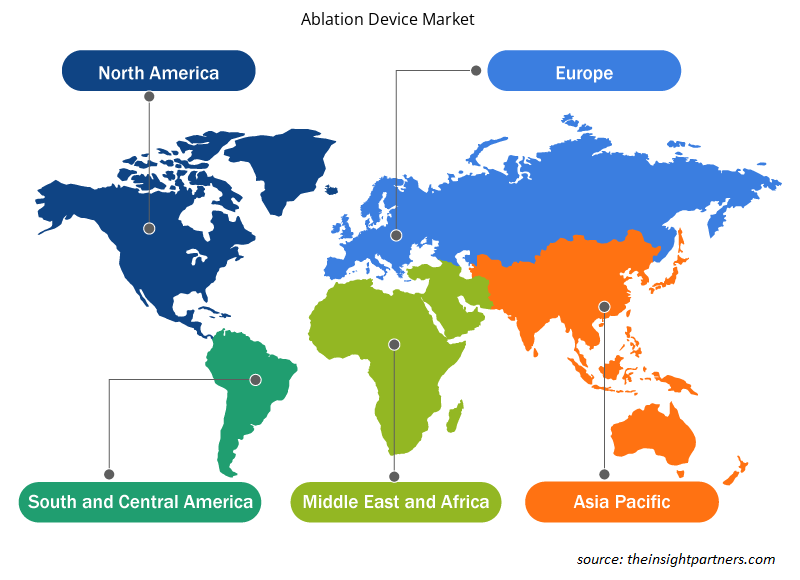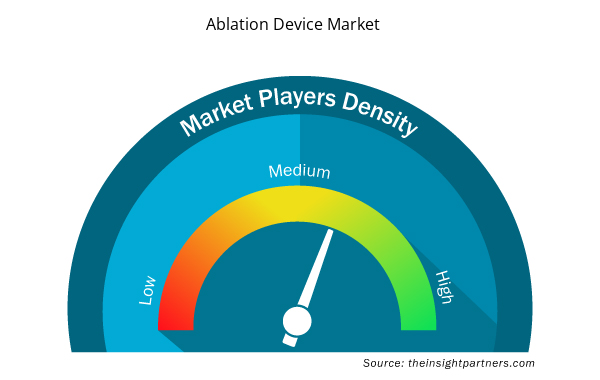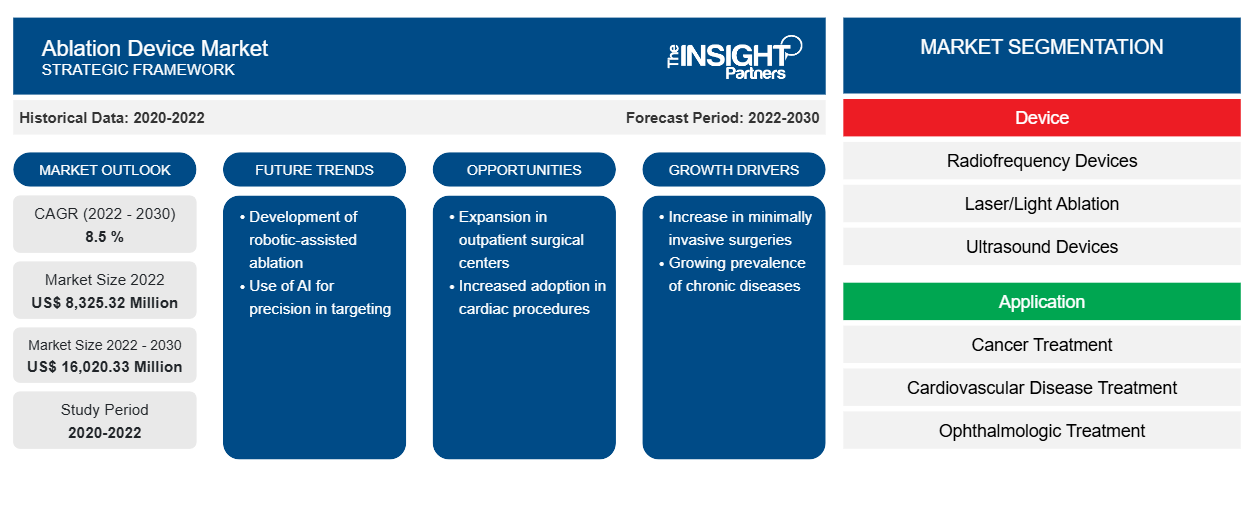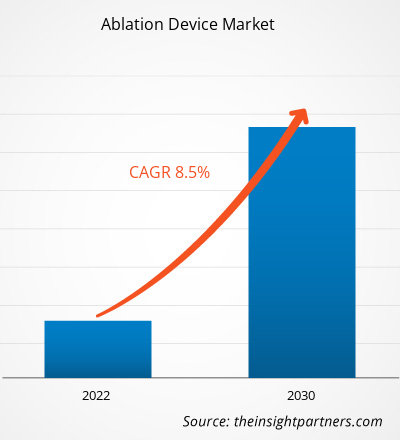[研究报告] 2022 年消融设备市场价值为 83.2532 亿美元,预计到 2030 年将达到 160.2033 亿美元;预计 2022 年至 2030 年的复合年增长率为 8.5%。
市场洞察和分析师观点:
消融是指通过手术切除器官、结构或部分。消融设备使用热量(通常由射频、射频、能量或激光产生)或极冷来造成轻微烧伤。推动消融设备市场增长的关键因素包括慢性病患病率不断上升、老年人口增加以及对微创手术的需求不断增加。然而,替代治疗方法和疗法的强势地位阻碍了市场增长。
增长动力和限制因素:
癌症、心血管疾病和呼吸系统疾病等慢性疾病的日益流行推动了全球消融设备市场的发展。消融手术为各种疾病提供了有效的治疗选择,包括肿瘤消融、心律失常和肺部疾病。根据世界卫生组织 (WHO) 的数据,每年非传染性疾病 (NCD) 是全球 4100 万人死亡的主要原因。此外,心血管疾病占 NCD 死亡人数的大多数,每年有 1790 万人死亡,其次是癌症(930 万)、慢性呼吸系统疾病(410 万)和糖尿病(200 万,包括糖尿病导致的肾病死亡)。同样,根据美国国家癌症研究所 (NCI) 的数据,癌症正日益成为一个全球健康问题。2020 年,全球新增癌症病例超过 1930 万,导致约 1000 万人死于癌症。世界卫生组织估计,到 2040 年,全球每年可能有 2890 万例新发癌症病例,约 1620 万人死于癌症。慢性病负担的增加和对治疗方法的需求推动了对消融设备的需求。
此外,衰老是慢性疾病(尤其是心血管疾病和癌症)的重要风险因素。根据国际抗癌联盟 (UICC) 的数据,衰老是癌症的重要风险因素,老年人的癌症发病率较高。根据世界卫生组织 (WHO) 的数据,2015 年至 2050 年期间,世界 60 岁以上人口的比例将从 12% 增加到 22%,几乎翻了一番。根据 NCBI 于 2023 年 1 月发布的一项研究,在美国,到 2050 年,50 岁及以上人口的数量将达到 2.2113 亿,较 2020 年的 1.3725 亿迅速增加。50 岁及以上的人预计患有至少一种慢性疾病,这一数字预计将从 2020 年的 7152 万人增加 99.5% 到 2050 年的 1.4266 亿。此外,预计到 2050 年,约有 1400 万人可能患有多种疾病。消融手术为可能具有更高手术风险的老年人群体提供了微创治疗选择。因此,老年人口的增加,加上慢性病患病率的上升,推动了消融设备市场的增长。
然而,消融技术面临着来自替代治疗方法的竞争,包括外科手术、放射疗法、全身药物疗法和其他微创手术。根据所治疗的具体病症,医疗保健提供者可能会根据疗效、安全性、患者资格、成本效益或资源可用性等因素选择替代治疗方式。替代治疗方案的可用性和偏好可能会限制消融设备的采用和使用。例如,由于公众对传统癌症治疗的认知度高、发展中国家先进治疗方案的采用率低以及外科医生不愿放弃传统治疗方案,手术、化疗和放射疗法等治疗方法在癌症治疗中更受青睐。因此,上述因素阻碍了消融设备市场的增长。
定制此报告以满足您的需求
您可以免费定制任何报告,包括本报告的部分内容、国家级分析、Excel 数据包,以及为初创企业和大学提供优惠和折扣
- 获取此报告的关键市场趋势。这个免费样品将包括数据分析,从市场趋势到估计和预测。
报告细分和范围:
全球消融设备市场根据设备、应用和最终用户进行分类。根据设备,消融设备市场细分为射频设备、激光/光消融、超声波设备、冷冻消融设备等。根据应用,消融设备分为癌症治疗、心血管疾病治疗、眼科治疗、妇科治疗、泌尿科治疗、整容手术等。就最终用户而言,市场分为医院和诊所、门诊手术中心等。根据地理位置,消融设备市场分为北美(美国、加拿大和墨西哥)、欧洲(德国、法国、意大利、英国、俄罗斯和欧洲其他地区)、亚太地区(澳大利亚、中国、日本、印度、韩国和亚太其他地区)、中东和非洲(南非、沙特阿拉伯、阿联酋和中东和非洲其他地区)以及南美洲和中美洲(巴西、阿根廷和南美洲和中美洲其他地区)。
节段分析:
消融设备市场按设备细分为射频设备、激光/光消融、超声设备、冷冻消融设备等。射频设备细分市场在 2022 年占据了较大的市场份额,预计同一细分市场在 2022-2030 年期间的复合年增长率将更高。射频消融是一种微创手术,用于治疗肌瘤、骨骼、组织、甲状腺、子宫内膜、静脉曲张等。它是传统外科手术的替代方案。
消融设备市场按应用细分为癌症治疗、心血管疾病治疗、眼科治疗、妇科治疗、泌尿科治疗、整容手术等。心血管疾病治疗领域在 2022 年占据了更大的市场份额;此外,预计同一领域在 2022-2030 年期间的复合年增长率将更高。
按照终端用户划分,消融设备市场分为医院和诊所、门诊手术中心和其他。2022 年,医院和诊所占据最大市场份额,预计同一细分市场在 2022-2030 年期间的复合年增长率最高。医院和诊所是消融设备的主要终端用户,因为它们提供广泛的医疗服务,包括需要消融的非侵入性手术。
区域分析:
根据地理位置,全球消融设备市场分为五个主要区域:北美、欧洲、亚太、南美和中美以及中东和非洲。预计亚太地区在 2022-2030 年期间的复合年增长率最高。印度和中国等亚太国家在消融设备市场的增长方面具有巨大潜力。该地区的发展中国家医疗基础设施不断改善、医疗支出不断增加,并且越来越注重采用先进的医疗技术,为市场扩张提供了机会。随着新兴市场对医疗基础设施的投资以及越来越多的医生接触到先进的消融技术,对消融设备的需求将会增加,从而推动亚太地区的市场增长。
2022 年,北美占据了消融设备市场的最大份额。美国在 2022 年占据了最大的消融设备市场的最大份额,并且很可能在 2022-2030 年期间继续保持这一趋势。根据美国癌症协会的估计,2021 年有超过 190 万人被诊断出患有癌症,608,570 人死于该疾病。此外,在美国,每 2 名男性中就有 1 名和每 3 名女性中就有 1 名可能在其一生中被诊断出患有癌症。因此,癌症在人群中的高患病率推动了美国消融设备市场的增长。
根据美国医疗保险和医疗补助服务中心的数据,2021 年美国全国医疗支出增长 2.7%,达到 4.3 万亿美元,即每人 12,914 美元。此外,医疗支出占全国国内生产总值 (GDP) 的 18.3%。根据美国卫生与公众服务部的数据,预计 2019-2028 年全国医疗支出年增长率为 5.4%,到 2028 年将达到 6.2 万亿美元。医疗支出的增加可能会导致药物相关研发资金增加,从而刺激学术界对消融设备的需求。
消融设备市场区域洞察
Insight Partners 的分析师已详细解释了预测期内影响消融设备市场的区域趋势和因素。本节还讨论了北美、欧洲、亚太地区、中东和非洲以及南美和中美洲的消融设备市场细分和地理位置。

- 获取消融设备市场的区域特定数据
消融设备市场报告范围
| 报告属性 | 细节 |
|---|---|
| 2022 年市场规模 | 83.2532 亿美元 |
| 2030 年市场规模 | 160.2033亿美元 |
| 全球复合年增长率(2022 - 2030 年) | 8.5% |
| 史料 | 2020-2022 |
| 预测期 | 2022-2030 |
| 涵盖的领域 | 按设备
|
| 覆盖地区和国家 | 北美
|
| 市场领导者和主要公司简介 |
|
市场参与者密度:了解其对商业动态的影响
消融设备市场正在快速增长,这得益于终端用户需求的不断增长,而这些需求又源于消费者偏好的不断变化、技术进步以及对产品优势的认识不断提高等因素。随着需求的增加,企业正在扩大其产品范围,进行创新以满足消费者的需求,并利用新兴趋势,从而进一步推动市场增长。
市场参与者密度是指在特定市场或行业内运营的企业或公司的分布情况。它表明在给定市场空间中,相对于其规模或总市场价值,有多少竞争对手(市场参与者)存在。
在消融设备市场运营的主要公司有:
- 雅培实验室
- AngioDynamics 公司
- AtriCure 公司
- 百多力
- 波士顿科学公司
免责声明:上面列出的公司没有按照任何特定顺序排列。

- 了解消融设备市场顶级关键参与者概况
行业发展和未来机遇:
消融领域的技术进步显著提高了手术的有效性和安全性。较新的消融设备采用了射频、微波、冷冻消融和激光等先进技术,能够精确地破坏组织,同时最大限度地减少对周围健康组织的损伤。这些进步提高了成功率,扩大了消融手术的范围,推动了市场增长。全球消融设备市场的主要参与者采取的各种举措如下:
以下是全球消融设备市场的一些最新发展:
- 2023年5月,雅培的TactiFlex消融导管(带传感器)获得美国食品药品监督管理局(FDA)批准,该导管成为世界上第一款采用柔性尖端和接触力技术的消融导管。
- 2023 年 2 月,Hologic Inc. 的 NovaSure V5 全局子宫内膜消融 (GEA) 设备在加拿大和欧洲获准用于医疗用途。此创新版本包含增强功能,可治疗各种宫颈和子宫解剖结构。
- 2021 年 11 月,美敦力印度公司在印度推出了用于治疗房颤 (AF) 的 Arctic Front 心脏冷冻消融导管系统。该系统用于进行微创冷冻球囊导管消融,这是治疗 AF 的治疗方法之一。
- 2021 年 1 月,美敦力公司获得 FDA 批准使用 DiamondTemp 消融 (DTA) 系统,该系统适用于治疗复发性、有症状的阵发性房颤患者,特别是对常规药物无效的患者。DTA 是首个获得 FDA 批准的、温控、灌注式钻石射频 (RF) 消融 系统,目前可用于进行消融。
- 2020 年 12 月,Acutus Medical 在欧洲推出了 AcQBlate 力感应消融系统。该产品是在 AcQBlate Force 消融导管和 Qubic 力感应模块获得 CE 标志后推出的。该消融系统所采用的 AcQBlate Force 是市场上唯一一款商用的金尖、灌溉、力感应射频消融导管。该系统还集成了 Acutus Medical 与 BIOTRONIK 的国际联盟提供的两个最先进的组件——Qubic RF 和 Qiona 灌溉泵。
- 2020 年 11 月,雅培宣布推出 IonicRF 发生器,该设备已获得 FDA 批准,可提供非手术、微创治疗,用于治疗神经系统疼痛。这种射频消融设备利用热量来瞄准特定神经并阻止疼痛信号到达大脑。该设备目前已获准在美国和欧洲销售。
竞争格局和重点公司:
雅培实验室、AngioDynamics Inc、AtriCure Inc、Biotronik、波士顿科学公司、Conmed Corporation、强生公司、美敦力公司、奥林巴斯公司和施乐辉公司是消融设备市场的知名企业。这些公司专注于新技术、现有产品的改进和地域扩张,以满足全球日益增长的消费者需求,并增加其专业产品组合的产品范围。
- 历史分析(2 年)、基准年、预测(7 年)及复合年增长率
- PEST 和 SWOT 分析
- 市场规模价值/数量 - 全球、区域、国家
- 行业和竞争格局
- Excel 数据集


- Lyophilization Services for Biopharmaceuticals Market
- Flexible Garden Hoses Market
- Architecture Software Market
- Pharmacovigilance and Drug Safety Software Market
- Vessel Monitoring System Market
- Vaginal Specula Market
- Europe Tortilla Market
- Single Pair Ethernet Market
- Foot Orthotic Insoles Market
- Cling Films Market

Report Coverage
Revenue forecast, Company Analysis, Industry landscape, Growth factors, and Trends

Segment Covered
This text is related
to segments covered.

Regional Scope
North America, Europe, Asia Pacific, Middle East & Africa, South & Central America

Country Scope
This text is related
to country scope.
常见问题
The ablation device market, by device, is segmented into radiofrequency devices, laser/light ablation, ultrasound devices, cryoablation devices, and others. The radiofrequency devices segment held a larger market share in 2022, and the same segment is anticipated to register a higher CAGR during 2022-2030.
The ablation device market, by application, is segmented into cancer treatment, cardiovascular disease treatment, ophthalmologic treatment, gynecological treatment, urological treatment, cosmetic surgery, and others. The cardiovascular disease treatment segment held a larger market share in 2022; also, the same segment is anticipated to register a higher CAGR during 2022-2030.
Key factors driving the ablation device market growth include the growing prevalence of chronic diseases, an increase in the geriatric population, and increasing demand for minimally invasive procedures.
The ablation device market majorly consists of the players, including Abbott Laboratories, AngioDynamics Inc, AtriCure Inc, Biotronik, Boston Scientific Corporation, Conmed Corporation, Johnson and Johnson, Medtronic PLC, Olympus Corporation, and Smith & Nephew PLC.
Ablation refers to the surgical removal of an organ, structure, or part. Ablation devices use heat (usually generated by radio frequency, RF, energy, or a laser) or extreme cold to cause minor burns.
The ablation device market was valued at US$ XX.XX million in 2022.
The ablation device market is expected to be valued at US$ XX.XX million in 2030.
The ablation device market, by end users, is segmented into hospitals and clinics, ambulatory surgical centers, and others. In 2022, the hospitals and clinics segment held the largest market share, and the same segment is anticipated to register the highest CAGR during 2022–2030.
Trends and growth analysis reports related to Life Sciences : READ MORE..
The List of Companies - Ablation Device Market
- Abbott Laboratories
- AngioDynamics, Inc.
- AtriCure, Inc.
- Biotronik
- Boston Scientific Corporation
- Conmed Corporation
- Johnson and Johnson
- Medtronic PLC
- Olympus Corporation
- Smith & Nephew PLC
The Insight Partners performs research in 4 major stages: Data Collection & Secondary Research, Primary Research, Data Analysis and Data Triangulation & Final Review.
- Data Collection and Secondary Research:
As a market research and consulting firm operating from a decade, we have published and advised several client across the globe. First step for any study will start with an assessment of currently available data and insights from existing reports. Further, historical and current market information is collected from Investor Presentations, Annual Reports, SEC Filings, etc., and other information related to company’s performance and market positioning are gathered from Paid Databases (Factiva, Hoovers, and Reuters) and various other publications available in public domain.
Several associations trade associates, technical forums, institutes, societies and organization are accessed to gain technical as well as market related insights through their publications such as research papers, blogs and press releases related to the studies are referred to get cues about the market. Further, white papers, journals, magazines, and other news articles published in last 3 years are scrutinized and analyzed to understand the current market trends.
- Primary Research:
The primarily interview analysis comprise of data obtained from industry participants interview and answers to survey questions gathered by in-house primary team.
For primary research, interviews are conducted with industry experts/CEOs/Marketing Managers/VPs/Subject Matter Experts from both demand and supply side to get a 360-degree view of the market. The primary team conducts several interviews based on the complexity of the markets to understand the various market trends and dynamics which makes research more credible and precise.
A typical research interview fulfils the following functions:
- Provides first-hand information on the market size, market trends, growth trends, competitive landscape, and outlook
- Validates and strengthens in-house secondary research findings
- Develops the analysis team’s expertise and market understanding
Primary research involves email interactions and telephone interviews for each market, category, segment, and sub-segment across geographies. The participants who typically take part in such a process include, but are not limited to:
- Industry participants: VPs, business development managers, market intelligence managers and national sales managers
- Outside experts: Valuation experts, research analysts and key opinion leaders specializing in the electronics and semiconductor industry.
Below is the breakup of our primary respondents by company, designation, and region:

Once we receive the confirmation from primary research sources or primary respondents, we finalize the base year market estimation and forecast the data as per the macroeconomic and microeconomic factors assessed during data collection.
- Data Analysis:
Once data is validated through both secondary as well as primary respondents, we finalize the market estimations by hypothesis formulation and factor analysis at regional and country level.
- Macro-Economic Factor Analysis:
We analyse macroeconomic indicators such the gross domestic product (GDP), increase in the demand for goods and services across industries, technological advancement, regional economic growth, governmental policies, the influence of COVID-19, PEST analysis, and other aspects. This analysis aids in setting benchmarks for various nations/regions and approximating market splits. Additionally, the general trend of the aforementioned components aid in determining the market's development possibilities.
- Country Level Data:
Various factors that are especially aligned to the country are taken into account to determine the market size for a certain area and country, including the presence of vendors, such as headquarters and offices, the country's GDP, demand patterns, and industry growth. To comprehend the market dynamics for the nation, a number of growth variables, inhibitors, application areas, and current market trends are researched. The aforementioned elements aid in determining the country's overall market's growth potential.
- Company Profile:
The “Table of Contents” is formulated by listing and analyzing more than 25 - 30 companies operating in the market ecosystem across geographies. However, we profile only 10 companies as a standard practice in our syndicate reports. These 10 companies comprise leading, emerging, and regional players. Nonetheless, our analysis is not restricted to the 10 listed companies, we also analyze other companies present in the market to develop a holistic view and understand the prevailing trends. The “Company Profiles” section in the report covers key facts, business description, products & services, financial information, SWOT analysis, and key developments. The financial information presented is extracted from the annual reports and official documents of the publicly listed companies. Upon collecting the information for the sections of respective companies, we verify them via various primary sources and then compile the data in respective company profiles. The company level information helps us in deriving the base number as well as in forecasting the market size.
- Developing Base Number:
Aggregation of sales statistics (2020-2022) and macro-economic factor, and other secondary and primary research insights are utilized to arrive at base number and related market shares for 2022. The data gaps are identified in this step and relevant market data is analyzed, collected from paid primary interviews or databases. On finalizing the base year market size, forecasts are developed on the basis of macro-economic, industry and market growth factors and company level analysis.
- Data Triangulation and Final Review:
The market findings and base year market size calculations are validated from supply as well as demand side. Demand side validations are based on macro-economic factor analysis and benchmarks for respective regions and countries. In case of supply side validations, revenues of major companies are estimated (in case not available) based on industry benchmark, approximate number of employees, product portfolio, and primary interviews revenues are gathered. Further revenue from target product/service segment is assessed to avoid overshooting of market statistics. In case of heavy deviations between supply and demand side values, all thes steps are repeated to achieve synchronization.
We follow an iterative model, wherein we share our research findings with Subject Matter Experts (SME’s) and Key Opinion Leaders (KOLs) until consensus view of the market is not formulated – this model negates any drastic deviation in the opinions of experts. Only validated and universally acceptable research findings are quoted in our reports.
We have important check points that we use to validate our research findings – which we call – data triangulation, where we validate the information, we generate from secondary sources with primary interviews and then we re-validate with our internal data bases and Subject matter experts. This comprehensive model enables us to deliver high quality, reliable data in shortest possible time.


 获取此报告的免费样本
获取此报告的免费样本